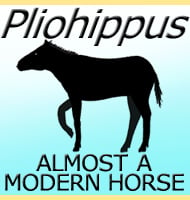Pliohippus
In Depth In the on-going evolution of horses Pliohippus represents the next stage after forms like Merychippus. The most noted feature of Pliohippus is that it has even more developed hoof feet supported by the middle toe, with the two side toes being reduced so much that in life they would have been barely visible … Read more
